USDA Forest Service Missoula Technology and Development Center Facilities Toolbox: Accessibility Tools
USDA Forest Service Missoula Technology and Development Center Facilities Toolbox: Accessibility Tools
This accessible precast concrete vault toilet is at Lee Creek Campground near Lolo, MT. The toilet also serves a winter cross-country ski trailhead.
Forest: Lolo
District: Lolo
Region: 1
This section of the facilities toolbox provides information to help integrate accessibility into facilities while complying with legal requirements and codes. The topics below address common concerns and provide links to detailed information.
Disabled or handicapped or ??? Which terms should be used?
Though individuals who have disabilities use a variety of terms to refer to themselves, as an agency we must ensure that we use terminology that complies with legal direction and is considered acceptable by the majority of people. With these points in mind, the following guidance is offered.
The two terms most commonly used to describe a person who has a limitation are "handicapped" and "disabled."
A disability is the result of a medically definable condition that limits a person's movements, senses, or activities.
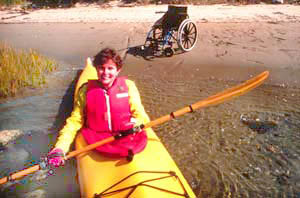
There is no "handicap" or "barrier" when this person with a disability is in her sea kayak.
A handicap is a barrier or circumstance that makes progress or success difficult, such as an impassable flight of stairs or a negative attitude toward a person who has a disability.
A practical example: Janet Zeller, who has quadriplegia (some level of paralysis in all four limbs), has been told that she doesn't look "handicapped" when she is out paddling her sea kayak. Think about the situation. When Janet is paddling her sea kayak she is part of a sleek craft gliding through the water. There are no barriers to stop her or to "handicap" her. But she still has a disability.
The correct term is "disability"—a person with a disability. Person-first terminology is used because the person is more important than his or her disability.
Examples of person-first terminology:
-
" the person who is blind"—not the blind person
-
" the person who uses a wheelchair"—not the wheelchair person.
It is also important to understand that there are negative connotations to the term "handicapped" when referring to a person who has a disability. The word has been around for centuries, but was not used to refer to people with disabilities until the late 1800s. Many people believe that the term "handicapped" was first used in relation to individuals who have disabilities when Civil War veterans whose injuries prevented them from working were begging on the streets with "cap in hand." Standard references do not support this story. But because the story has become legend and begging for a living is degrading, describing people with disabilities as "handicapped" is offensive.
In 1992, when Section 504 of the Rehabilitation Act was renewed and amended, one of the amendments was to correct terminology. Recognizing the negative impact of certain terms, the word "handicapped" was replaced with the phrase "persons with disabilities."
Also in 1992, Federal agencies were directed to correct terminology in their regulations, policies, and other documents. So when you participate in updating policies, the Forest Service Handbook or Manual, guidelines for the agency, direction to the field, or have input into other documents, please use the opportunity to correct the term "handicapped" and other references to persons with disabilities that do not place the person first.
Accessible means in compliance with the Federal accessibility guidelines and standards. Accessible sites and facilities do not contain barriers limiting their use by people with disabilities.
A site, facility, or program is accessible, or it is not accessible. The only way to evaluate accessibility is by using the legal standards and guidelines.
There are no shades of accessibility.
For instance, a parking space either meets the requirements and is accessible or it does not meet the requirements and is not accessible. The specific surfacing, slope, size, and walkway connection requirements must be met, regardless of the conditions around the parking space. "Almost" doesn't count.
If you have questions or concerns about this direction, or the use of other terms, please contact Janet Zeller, USDA Forest Service, Accessibility Program Manager, Recreation, Heritage, and Wilderness Resources staff in the Washington, DC, office. Her phone number is (202) 205-9597. Her e-mail is jzeller@fs.fed.us.
What does "accessible" mean?
The term "accessible" means in compliance with the accessibility guidelines.
A site, facility, or program either meets the requirements of the Federal accessibility standards and guidelines or it does not meet the requirements and is not accessible. Accessibility is only evaluated using these standards and guidelines. There is no such thing as "partially accessible," although it is possible for parts of a facility to be accessible while other parts are not.
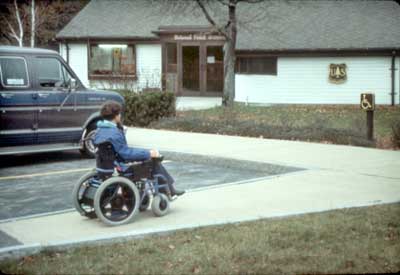
An accessible District office entrance.
Forest: White Mountain
District: Saco
Region: 9
As with all building codes, facilities must comply with the accessibility standards and guidelines in effect when they are constructed. Many of our facilities predate accessibility laws, but all Federal facilities must be accessible, with few exceptions, regardless of age. Once we bring a facility up to current accessibility standards and guidelines, that facility is considered accessible even if there are changes to the standards and guidelines later. However, if a facility is altered, reconstructed, or replaced, it must be brought into compliance with the highest standard of Federal or Forest service accessibility guidelines in place at that time.
Which accessibility guidelines must we use?
First, here's a little background about laws, guidelines, and standards:
The laws governing accessibility include:
The 1968 law—the Architectural Barriers Act (ABA)—requires that facilities built, bought, rented, or leased by or on behalf of a Federal agency must be accessible.
The 1973 law—Section 504 of the Rehabilitation Act — requires provision of equal opportunity for individuals with disabilities to participate in all Federal or federally-funded programs and activities.
-
The 1994 USDA regulation—7 CFR 15e and 15b —is the USDA implementation of Section 504. It provides specific requirements for ensuring the accessibility of the programs and activities conducted by or for USDA agencies.
The 1990 law—the Americans with Disabilities Act (ADA)—prohibits discrimination on the basis of disability in public accommodations and commercial transportation in the private sector and in State and local government. This law includes requirements for accessible new construction and renovation, reasonable accommodation, transportation, telecommunications, and just about everything affecting people's daily lives. However, the ADA does not apply to the programs and facilities provided by Federal agencies, except for Title V Section 507 of the ADA, which pertains to federally designated wilderness areas. The ADA is modeled on the 1968 Architectural Barriers Act (ABA) and Section 504 of the Rehabilitation Act of 1973.


The guidelines and standards resulting from these laws include:
The new ADA/ABA Accessibility Guidelines were officially published in the Federal Register on July 23, 2004. The new combined guidelines replace both the Uniform Federal Accessibility Standards (UFAS) and the Americans with Disabilities Act Accessibility Guidelines (ADAAG). The ADA/ABA Accessibility Guidelines cover all of the facilities and associated features that were addressed in the UFAS and the ADAAG. The General Services Administration (GSA) officially adopted the ABA portion of the combined guidelines in November 2005. The Architectural Barriers Act Accessibility Standards (ABAAS) is the name given by GSA to the standards the Forest Service must follow for all construction and alterations that begin after May 8, 2006.
The new combined guidelines have two chapters 1 and 2. Chapters ADA1 and ADA2 contain the application, administration, and scoping requirements for all entities under the ADA (state and local governments and public accommodations). Chapters ABA1 and ABA2 contain the application, administration, and scoping requirements for all entities under the ABA (Federal agencies). All numbering in chapters ABA1 and ABA2 begins with F for Federal. The Forest Service is to follow only the ABA1 and ABA2 chapters for guidance and scooping. Be sure the scoping direction you are following starts with the letter F.
Chapters 3 through 10 contain the common set of technical provisions. The technical provisions are now the same for federal, state, and local governments, as well as public accommodations. The technical provisions are now also more consistent with the model building codes, including the International Building Codes, and with industry standards such as the American National Standards Institute. The modifications should eliminate a good deal of confusion over which guidelines and standards are appropriate in different situations.
Updates to accessibility guidelines and terminology:
Do NOT follow the information in the 1993 publication Universal Access to Outdoor Recreation, A Design Guide with its three levels of difficult, easier, moderate.
Do NOT follow the information in the 1999 Draft Outdoor Recreation Developed Areas accessibility recommendations. In particular, don't post the wheelchair symbol at all accessible campsites.
DO follow the ADA/ABA Accessibility Guidelines for buildings and facilities.
DO follow the Forest Service Outdoor Recreation Accessibility Guidelines (FSORAG) and the Forest Service Trail Accessibility Guidelines (FSTAG). The Accessibility Guidebook for Outdoor Recreation and Trails explains how to use the FSORAG and FSTAG.
Does the Americans with Disabilities Act (ADA) apply to the Forest Service?
No, with one exception. Except for the section that applies to Federal wilderness areas, the programs and facilities of Federal agencies are NOT governed by the Americans with Disabilities Act (ADA) of 1990.
Why not? Federal agencies have been required to have accessible facilities since 1968, when the Architectural Barriers Act (ABA) became law. Federal agencies have been required to have accessible programs and activities since 1973, when Section 504 of the Rehabilitation Act was passed. The ADA, which became law in 1990, was modeled on those two laws. It applies to State and local government services and public accommodations.
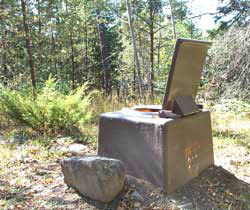
This pit toilet in the Boundary Waters Canoe Area Wilderness is an accessible facility with minimum impact on the resource.
Forest: Superior
District: Ely
Region: 9
The section of the ADA that does govern Federal agencies is Title V Section 507 of the ADA, which pertains to Federal wilderness areas. This section reaffirms that the 1964 Wilderness Act doesn't prohibit the use of wheelchairs and also that agencies aren't required to change the character of wilderness areas in order to provide accessibility. It also defines the types of wheelchairs that can be used in federally designated wilderness. Facilities do not have to be constructed solely because a person with a disability might go to a wilderness area. However, if an agency decides to construct a facility, it must be accessible. For instance, in some areas of the Boundary Waters Canoe Area Wilderness, pit toilets have been provided for environmental reasons. The design of these toilets has been modified so that they are accessible.
Special-use permit holders must comply with the ABA and Section 504 because they are operating federally "assisted" programs. Permit holders are also governed by the ADA because they are public accommodations. See the Guidelines section of this toolbox for more information about laws, guidelines, and standards.
Must all new or reconstructed facilities be accessible?
Yes—in accordance with the Architectural Barriers Act (ABA) of 1968, all new or reconstructed facilities that are built, bought, rented, or leased by or on behalf of a Federal agency are to be accessible, with few exceptions.
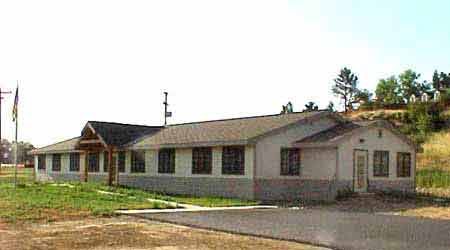
The accessible Ashland Ranger District office was
constructed in 1998. The former office, built in 1936,
is barely visible on the hill in the upper right corner of the photo.
Forest: Custer
District: Ashland
Region: 1
Forest Service Handbook 7309.11.34.16.1.g details a few very specific exemptions to accessibility requirements in new and existing Forest Service buildings. These include observation galleries, mechanical equipment rooms, and spaces or facilities designed for use by employees needing considerable dexterity and special abilities. Please check the Forest Service Handbook for details about these limited exceptions.
Do facilities in remote locations have to be accessible?
Yes, they do.
The Forest Service must give everyone the opportunity to use Forest Service facilities and programs.
As designers or managers, we do not decide whether or not a person can or would want to visit remote areas or areas where access is difficult. Our visitors make those decisions for themselves in the same way they decide whether or not to go skiing or fishing. If the Forest Service builds a facility, even in remote areas or areas that are difficult to access (including wilderness), the facility must be accessible, with few exceptions.
However, the Forest Service’s mission also includes protecting resources and settings—including historic structures and fragile ecosystems. Any facility newly constructed or significantly altered by or for the Forest Service (buildings, toilets, picnic tables, fire rings, etc.), must be accessible, with very few exceptions. The decision not to make a facility accessible in accordance with the full UFAS/ADDAG standards, occurs only when the measures needed to meet the accessibility guidelines would fundamentally alter the program, environment, or historic resource. The Forest Service Outdoor Recreation Accessibility Guidelines (FSORAG) provide guidance for campsites, tent pads and platforms, viewing overlooks, outdoor showers, picnic tables, fire rings and grills, utility sinks, and pit toilets as well as other facilities located in remote areas. The Forest Service Trails Accessibility Guidelines (FSTAG) provide the specific information needed to ensure that accessibility is maximized on newly constructed or altered pathways or trails that are managed for pedestrian or hiker use, while protecting the resource without fundamentally altering the program.
Applying this guidance may require some ingenuity. For instance, in the Boundary Waters Canoe Area Wilderness, pit toilets have been installed at 2,200 primitive campsites to protect the environment. These toilets are simply risers placed over a pit, with no walls. The Superior National Forest has developed an accessible riser for these remote settings. Grab bars are not required because the toilets have no walls. The Superior National Forest’s riser is a design that is appropriate to the setting and meets the accessibility standards. The familiar and accessible Forest Service SST-type toilets could not be constructed in the Boundary Waters Canoe Area Wilderness without fundamentally altering the environment.
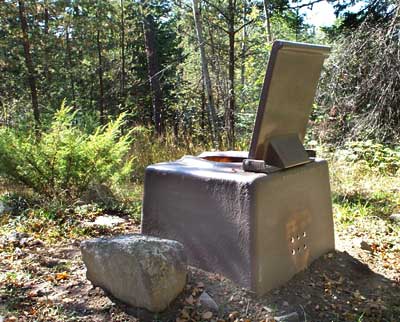
This accessible toilet facility is appropriate to its wilderness setting.
It has a square riser at the required accessible height of 17 to 19
inches above the ground, a backrest lid, and no walls.
Forest: Superior National Forest
District: Ely (Boundary Waters Canoe Area Wilderness)
Region: 9
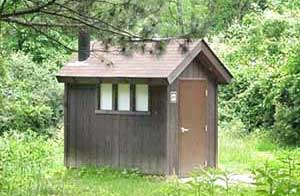
Standard SST (sweet smelling) toilet.
Forest: Monongahela National Forest
District: White Sulphur
Region: 9
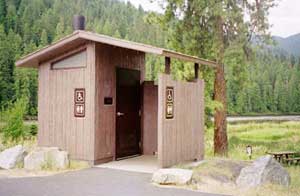
Standard SST (sweet smelling) toilet.
Forest: Nez Perce
District: Moose Creek
Region: 1
What is program accessibility?
Section 504 of the Rehabilitation Act of 1973 requires that individuals with disabilities have an equal opportunity to participate in all federally conducted and federally assisted programs and activities. Such access is to be provided in the most integrated setting, with each person participating as independently as possible.
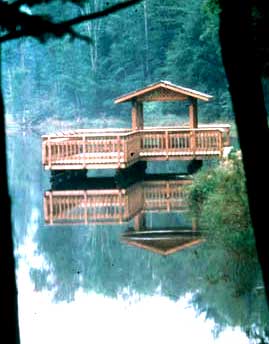
A "program" can be defined as the reason a person visits an area and may include:
-
Camping in a campground
-
Viewing the scene at a scenic overlook
-
Swimming at a beach
-
Enjoying solitude in the wilderness
-
Gathering information at a visitor’s center
-
Learning about an area on an interpretive trail
7 CFR 15e provides specific requirements for ensuring access to programs. If a program, such as an exhibit in a visitors’ information center, general forest information provided at an administrative office, or a campfire program in an amphitheater, is provided inside a structure, that facility should be accessible. Workplaces must be accessible, or potential employees with disabilities would be excluded from the "program," which in this case means employment.
If the facility is not yet accessible, the program must be temporarily provided in another manner. Any alternative program must integrate all customers and must not be a separate, segregated program just for persons with disabilities. For example, if a program has been held in an amphitheater that is not accessible, it should be conducted at an accessible location until the amphitheater is accessible, so that all can participate together in the evening program.
What is a transition plan? Does every facility need one?
A transition plan guides work needed to bring facilities and programs that are not accessible into compliance with accessibility standards. Every transition plan includes:
1. A list of obstacles to accessibility of the facility or program. An accessibility evaluation survey is conducted to determine the accessibility obstacles and issues.
2. A detailed description of the methods that will be used to provide accessibility.
3. A schedule for implementing the changes. If completion will take longer than a year, the steps that will be taken each year must be identified.
4. Signoff by the responsible Forest Service official. This official must have the authority to authorize the expenditure of funds to make the changes.
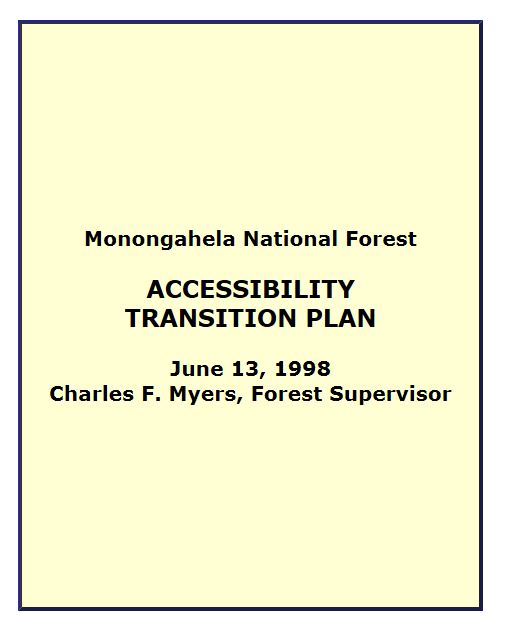
No standardized format was provided in 1991, when the Forest Service provided funding to each region to complete the transition plans. Each region, and in some cases each national forest, developed its own transition plan format.
Regional transition plan formats are available from the Regional Recreation Accessibility Coordinators or Regional Facilities Program Leaders (Web site available only to FS and BLM employees). If your region does not have a standard format, use the format for your forest. If your forest does not have a standard format, ask the region’s facilities program leader or recreation accessibility coordinator to recommend a format that has been used successfully by another forest or region.
Transition plans must be available to the public.
Does every existing facility need a transition plan? Yes, unless the facility is already accessible. 7 CFR 15e Section 150 Program Accessibility: Existing Facilities requires transition plans to be developed for every facility that does not currently provide program accessibility. Although some regions have approached transition plans by starting with 20 percent of the region’s facilities, the law requires transition plans for all facilities that are not accessible. The law does allow a program to be "viewed in its entirety" when evaluating its accessibility. However, if a program is not accessible because the facility is not accessible, the forest must develop and implement a transition plan for that program and facility.
Since the 1968 passage of the Architectural Barriers Act (ABA), newly acquired, constructed, or altered buildings that are owned, rented, or leased by or for a Federal agency have been required to be accessible. A lot of Forest Service facilities were built before 1968. Some of the facilities built since then were not designed or constructed in compliance with the requirements of the Uniform Federal Accessibility Standards.
In the early 1990s, the Forest Service began an aggressive attempt to correct accessibility deficiencies, calling for all units to complete a transition plan identifying the changes needed to make each facility accessible. Funding to complete the transition plans was provided to the regions in 1991, 1992, and 1993.
7 CFR 15e, the accessibility regulation governing all USDA agencies became law in December 1994. It includes a requirement for completing transition plans for all facilities that were not accessible by 12/31/1997. The specifics of developing a transition plan are cited in 7 CFR 15e Section 150(d). All units were informed of the timeline requirement.
In 1998, under Public Law 105-359, Congress mandated an evaluation of the accessibility of outdoor recreation on federally managed lands for both USDA and U.S. Department of the Interior agencies. The results of that independent study, published in June of 2000, highlighted to Congress that many Forest Service units had not completed their transition plans. The Forest Service is now under increased pressure to ensure that those plans are completed. That is why the national budget direction each year since Fiscal Year 2001 has included direction to the field to complete the transition plans.
What is an accessibility evaluation survey and when is one needed?
Completion of an accessibility evaluation survey is the first step in developing a transition plan. The survey determines whether or not a facility is accessible, and identifies what needs fixing if the facility is not.
An accessibility evaluation survey compares each portion of the structure to the accessibility standards.
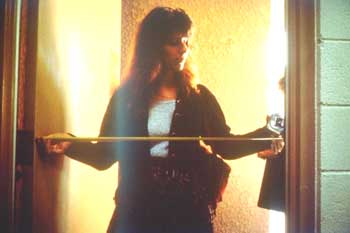
For example, doorways must be checked to see if they have at least 32 inches of "clear width." This is measured when the door is open 90 degrees for swinging doors and fully opened for other door types. The measuring tape is stretched from the face of the door to the nearest portion of the doorframe or latch mechanism on the latch side.
USDA has developed a Building/Site Accessibility Compliance Checklist that is available as Attachment F of the linked document and can be used as an evaluation guide. However, your region may have developed checklists that will better match your facilities. Check with your region or station facilities program leader (Web site available only to FS and BLM employees) or a regional recreation accessibility coordinator to find out if your region has developed its own checklist.
For recreation sites, consider using the Forest Service Accessibility Database. Check with your Regional Accessibility Coordinator for more information on the database. The Webinar recording What the FS Accessibility Database Can Do for You explains how you can use the database to record and track which recreation facilities on your unit are accessible, which facilities need work, options for accomplishing accessibility, and how to provide recreation accessibility information on the Web in a user–friendly manner.
How does universal design fit in?
Universal design means designing all programs and facilities to meet the needs of most people. Since the early 1990s, the Forest Service has followed a policy that all new and reconstructed facilities, programs, and associated elements are to be accessible. This commitment exceeds the minimum requirements of the ADA/ABA Accessibility Guidelines. Through the use of universal design, Forest Service facilities and programs provide an integrated experience. New and upgraded facilities don't have separate or "special" entrances, or features for persons with disabilities. The result is independence, integration, and dignity for everyone.
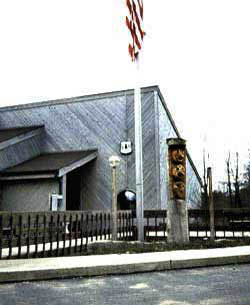
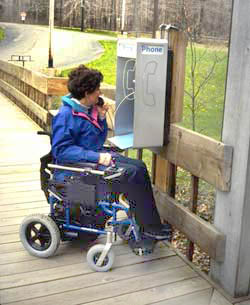
The entrance to this district office is universally designed even though it was constructed on a steep hillside.
Forest: Allegheny
District: Bradford
Region: 9
Following the principles of universal design, facilities are constructed so that the entrances require neither steps nor ramps, ensuring that all people can use the same entrance. The interiors are designed so that all individuals can access all areas. If the facility has more than one story, an elevator is provided. All aspects of the accessibility guidelines are met throughout the facility, including the requirements for visual alarms and tactile signage, in accordance with the accessibility guidelines.
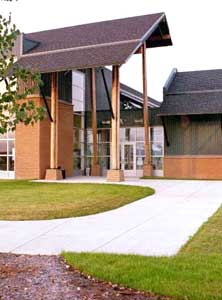
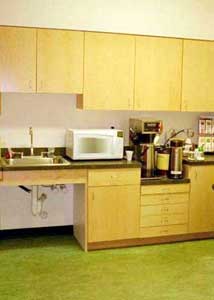
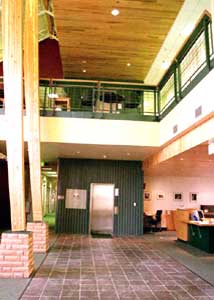
The Missoula Technology and Development Center building was designed and constructed in 2002 using the principals of universal design. Employees have found the universal design features have benefits for everyone.
When is a facility considered accessible?
A facility is accessible if it was constructed in compliance with the accessibility guidelines that were in force at the time of its construction. Many of our facilities predate accessibility laws, but all Federal facilities must be accessible, with few exceptions, regardless of age. Once we bring a facility up to current accessibility standards and guidelines, that facility is considered accessible even if there are changes to the standards and guidelines later. However, if a facility is altered, reconstructed, or replaced, it must be brought into compliance with the highest standard of Federal or Forest Service accessibility guidelines in place at that time.
The current accessibility guidelines include:
For buildings and related facilities:
-
The combined ADA/ABA Accessibility Guidelines replaced the Uniform Federal Accessibility Standards (UFAS) for Federal and federally-funded facilities and the Americans with Disabilities Act Accessibility Guidelines for places of public accommodation and commercial facilities in the private sector and State and local government facilities when it was published in the Federal Register on July 23, 2004.
-
Since 1995, Forest Service policy has been that the Forest Service would use both the Uniform Federal Accessibility Standards (UFAS) and the Americans with Disabilities Act Accessibility Guidelines (ADAAG). When both standards covered the same features, the Forest Service used the higher standard. Now, there is only the one combined standard.
For developed recreation areas:
-
The Forest Service Outdoor Recreation Accessibility Guidelines (FSORAG) apply to Forest Service outdoor recreation areas.
-
The Forest Service Trails Accessibility Guidelines (FSTAG) apply to Forest Service trails managed for hikers and pedestrians.
-
The ADAAG Recreation Facilities applies to boating facilities, fishing piers and platforms, golf courses, miniature golf courses, amusement rides, sports facilities, and swimming pools and spas in the private sector and to state and local government facilities. The Forest Service should also follow these guidelines based on the policy above.
-
The ADAAG Children's Play Areas applies to children's play areas in the private sector and to state and local government facilities. The Forest Service should also follow these guidelines per the policy above.
A site, facility, or program either meets the requirements of the Federal accessibility standards and guidelines and is accessible or it does not meet the requirements and is not accessible. Plans for some recreation site amenities that meet the requirements of the Federal accessibility standards are available to Forest Service employees at the Accessible Recreation Facilities site.
Two terms that are not correct are "ADA accessible" and "handicapped accessible."
Why not "ADA accessible"? The Americans with Disabilities Act (ADA) is not an accessibility guideline, it is a law. The Americans with Disabilities Act Accessibility Guidelines (ADAAG) is one of the accessibility guidelines. If a person is stating that the facility is in compliance with the ADAAG, verses the UFAS or the FSORAG, then that statement should be made in full. However there is generally no need to be that specific. Simply stating that the facility is accessible means it is in compliance with the highest accessibility guidelines for that type of facility.
Why not use the phrase "handicapped accessible"? A handicap is a barrier, such as stairs that handicap passage by a person using a wheelchair. The term "accessible" means "in compliance with the accessibility guidelines." An accessible facility has no barriers. So the term "handicap accessible" means "barrier-no barrier," which makes no sense. The correct terms are simply "accessible" and "not accessible."
When is a historic structure considered accessible?
Most buildings have a purpose, or "program." Section 504 of the Rehabilitation Act of 1973 requires that all federally conducted and federally assisted programs and activities be accessible. Usually, this means making the buildings housing the programs accessible using current standards. This requirement includes historic structures that are listed or are eligible to be listed in the National Register of Historic Places.
For more information on accessibility modifications to historic buildings, see the How Do I make Historic Facilities Accessible? section of the toolbox.
If an historic structure can't be made accessible without substantial impairment to significant historic features, then the function or program that building serves must be made accessible using an alternative method that is equal in quality and is provided in as integrated a setting as possible, in accordance with Section 504. In these cases, the program in an historic structure can be considered accessible, even though the building is not accessible.
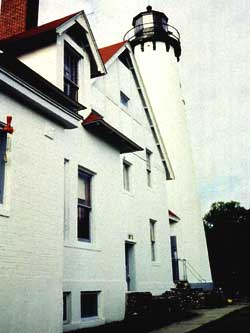
The Civilian Conservation Corps stonework on the Point Iroquois Lighthouse prevents adding a ramp to provide an accessible entrance.
Forest: Hiawatha
District: Sault Saint Marie
Region: 9
For Example:
Consider an historic Forest Service lighthouse that is open to the public. The fundamental program offered at the lighthouse is the interpretation of the area's history and culture, as well as a great view from the top of the light tower. However, the foundation is Civilian Conservation Corps stonework and there are stairs to all the entrances, to the second floor, and to the top of the tower. The State Historic Preservation Officer (SHPO) determined that the entrance stairs could not be altered nor could a ramp be installed without fundamentally altering significant historic features.
The forest developed an alternative program that is in compliance with Section 504. The forest decided to install interpretative panels along an accessible walkway around the outside of the lighthouse. The panels convey the same information provided inside, including the view from the top of the lighthouse. The work required to provide the alternative program experience was identified in the accessibility transition plan for that facility. Construction was completed. The program is considered accessible, although the building is not.
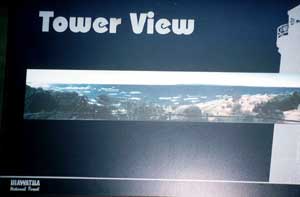
An alternative program experience is provided at the Point Iroquois Lighthouse. The program is accessible even though the lighthouse itself is not accessible.
Forest: Hiawatha
District: Sault Saint Marie
Region: 9
How can existing buildings be retrofitted to make them accessible?
Existing facilities that will remain in use and are not currently accessible must be evaluated for accessibility. A transition plan must be developed and implemented for each facility.
How can older facilities be made accessible when they have steps at the entrances, bathrooms that are too small, doors that are too narrow, kitchenettes with unreachable sinks, no elevators, and so forth? Budgeting for corrections and creative problem-solving are the keys to achieving accessibility in most cases. The following examples show how some accessibility problems have been corrected at Forest Service facilities around the country.
Steps at the entrances are a common problem. A number of creative solutions have been developed. Sometimes, the ground can be raised to eliminate the need for steps.
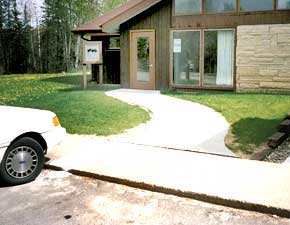
The original front steps of this building were obliterated by raising the elevation of the lawn to the base of the door. Then a new walkway was added.
Forest: Chippewa
District:Deer River
Region: 9
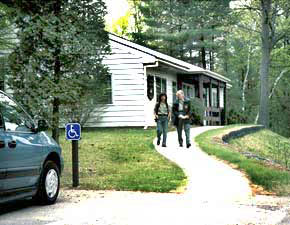
The original stepped terraced entrance to this building was replaced with a sloping walkway.
Forest: Green Mountain
District: Middlebury
Region: 9
Another approach is to add a deck that serves as a bridge over a low-elevation area.
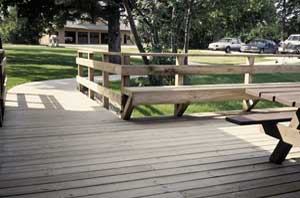
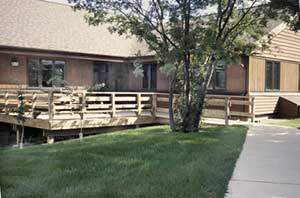
A deck was added to the Laurentian Ranger District office to provide an entrance that everyone can use, even though the building is on a steep hill.
Forest: Superior
District: Laurentian
Region: 9
The stairs at some facilities can't be modified as easily. At such facilities a separate ramp or an alternative entrance may have to be used. This may include adding an elevator or lift inside a two-story building. It is not acceptable to require people with disabilities to leave the building to reach another floor. In some cases, all services can be provided on one floor, achieving programmatic accessibility without physical accessibility to the entire structure.
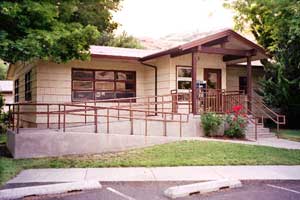
One way to retrofit an office with an accessible entrance.
Forest: Nez Perce
District:Salmon River
Region: 1
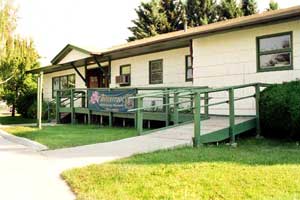
One way to retrofit an office with an accessible entrance.
Forest: Bitterroot
District:Stevensville
Region: 1
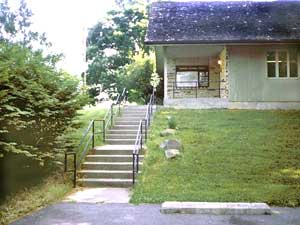
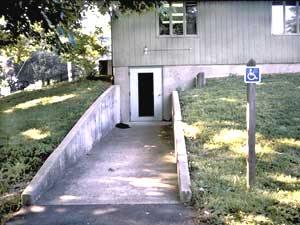
When a ramp can't be added appropriately, an alternative parking space and entrance may be necessary, with an elevator or lift inside the building
Forest: Shawnee
District: Murphysboro
Region: 9
If an elevator or lift is added to a building, all building code requirements must be met, including emergency egress.
An accessible restroom is essential. Often, existing restrooms can be renovated for accessibility.
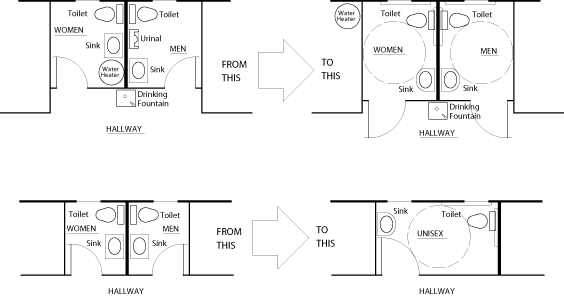
Some facilities have restrooms that are too small to retrofit and have no additional space for an accessible restroom. If no other options are available, two small restrooms located next to each other can sometimes be combined into one accessible restroom.
What can be done to improve accessibility during routine facility maintenance?
Improved accessibility does not always mean new construction or major renovation. Maintenance and routine service present many opportunities to improve accessibility.
Surfaces
An accessible surface is firm and stable. Use caution with the size and depth of gravel when maintaining unpaved surfaces. Generally, smaller graded gravel with some fine material can be compacted to a firmer surface than larger graded gravel or when all gravel particles are the same size. Depending on the surfacing material, mixing in some soil stabilizer might provide an accessible surface at little cost.
Rule of thumb:
If you could ride a narrow-tired bicycle AND if you could push a chubby 3-year-old child in an "umbrella" stroller across the surface without making ruts, a person in a wheelchair can probably cross the surface.
Parking Lots
Accessible parking spaces are to be included in parking lots. See the ADA/ABA Accessibility Guidelines section F208.2 to determine the required number of accessible spaces for various sizes of parking lots. Even very small lots must have at least one parking space that is van accessible (with an extra-wide parking space and access aisle). On paved parking lots, designating the required accessible spaces is relatively easy when repainting the parking lot stripes, especially right after the lot has been seal-coated. Designating accessible parking spaces on gravel lots is even easier. All you need is a sign and probably some parking bumpers.
Ensure that curb cuts for ramps are located appropriately—beside, not IN the parking space.
Getting In
Building entries must be flush with the grade of the outside access route and have a beveled doorsill that is not more than one-half inch high. Sometimes it's fairly easy to add surfacing material, shim up the deck or porch boards, or use asphalt or concrete to bring the access route up to the height of the building floor.
Water Hydrants
The surface at the base of water hydrants at recreation areas must be firm and stable with a 60-inch turning radius. See the "Surfaces" rule of thumb above. You can also build a wood or concrete surface around hydrants. If you don't have funding for a major site renovation, you can repair the area around a few hydrants at a time, starting with one or a few at each campground and picnic area.
Operating Controls
When parts need replacing, think of accessibility. All controls must be operable without pinching, grasping, or twisting the wrist and with no more than 5 pounds of pressure to comply with accessibility guidelines. This guideline includes the microwave in the kitchenette, the water fountain, the light switches, and the doorbell, as well as the sink faucets. If accessible parts are available or can be ordered, it makes sense to keep some on hand for future routine replacements.
For instance, faucets with accessible handles tend to be special-order items that are more expensive than faucets available off the shelf at the local hardware store. If you have some accessible faucets on hand, it's easy to replace faucets that are not accessible with the accessible ones when the old ones fail.
Rule of thumb:
If you can operate the control with a closed fist and with less than 5 pounds of pressure, the control is accessible.


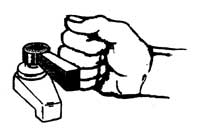
Gates, Bars, and Berms
Forest Service-constructed barriers on pedestrian travel routes must have a 32-inch minimum width gap or include a route beside them that will permit passage of a wheelchair. Frequently, a little shovel or carpentry work will correct the problems.
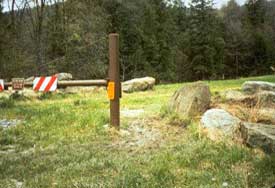
To meet accessibility guidelines, allow 32 inches of clear passage for foot travel around a gate.
Forest: Allegheny
Region: 9
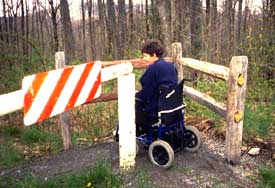
This three-post passage is accessible passage around a gate is accessible.
Forest: Monongahela
Region: 9
What terms will let people know whether our facility is accessible?
A site, facility, or program either meets the requirements of the Federal accessibility standards and guidelines and is accessible or it doesn't meet the requirements and is not accessible. Those are the only acceptable terms.
You've probably heard incorrect or imprecise terms such as "partially accessible," "accessible with assistance," "ADA accessible," "handicapped accessible," and "barrier-free."
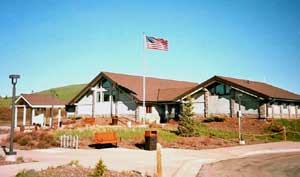
The Burgess Junction Visitor Center is accessible.
Forest: Bighorn
District: Tongue
Region: 2
Why not use terms such as "partially accessible" or "accessible with assistance"? There are no degrees of accessibility. A facility is either accessible, or it is not accessible. For more information on describing a facility that is not accessible, see the How should we describe facilities that only meet some of the accessibility guidelines? section of this toolbox.
Why not say "ADA accessible"? The Americans with Disabilities Act (ADA) is not an accessibility guideline, it is a law. The Americans with Disabilities Act Accessibility Guidelines (ADAAG) is one of several accessibility guidelines. When stating that the facility is in compliance with the ADAAG, rather than the UFAS or the FSORAG, that statement should be made in full. However, there is generally no need to be that specific. Simply stating that the facility is accessible means it is in compliance with the highest accessibility guidelines for that type of facility.
Why not use the phrase "handicapped accessible"? A handicap is a barrier or circumstance that makes progress or success difficult, such as stairs that handicap passage by a person using a wheelchair. The term accessible means in compliance with the Federal accessibility guidelines. An accessible facility has no barriers. So the term "handicap accessible" means "barrier-no barrier," which makes no sense. The best terms are simply "accessible" and "not accessible."
Why not say "barrier-free"? This term is not legally defined or commonly understood. The meaning of "accessible" is well defined in the accessibility guidelines, so there is no doubt about its implications.
How should we describe facilities that only meet some of the accessibility guidelines?
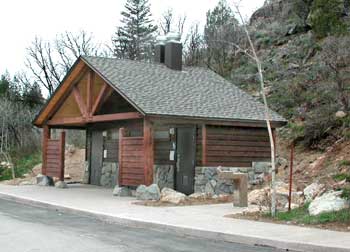
The Fish Creek Falls toilet is accessible. Forest: Routt
District: Hahns Peak/Bears Ears
Region: 2
There are no degrees of accessibility. If a facility does not conform to the accessibility guidelines, it is not accessible. Do not use terms such as "partially accessible" or "accessible with assistance."
If a facility is not accessible, visitors and employees need to know the specific portions or areas of the facility that are not accessible, and types of barriers. For locations where accessibility may influence people's plans for visiting, ensure that visitors can obtain accessibility information before they arrive. All facilities that are not accessible should include an information point near the building or site entrance that provides accessibility information. For instance, you can let people know that the main floor of the office is accessible but other floors can be reached by stairway only, and provide instructions on how to visit someone whose office is not on the main floor, or obtain an item or service that isn't located on the main floor. At a campground, you can let people know which specific campsites and trails are accessible and provide information on the barriers in other areas. Accessibility information can be integrated into the facility's Web page, along with travel directions, contact information, etc. The Trails and Trailheads page of the Sequoia National Forest web site shows one way to display this information. A link entitled "Accessibility Information" is always helpful. Employees at the facility should also be able to provide information about the accessibility of the facility to anyone who inquires. When relevant information is provided, people can make up their own minds about tackling the accessibility issues the facility presents.
If a facility is not accessible, the program housed in that facility must still be accessible to visitors and to employees. For example, at a district office that was constructed by the Civilian Conservation Corps, the front entrance could not be retrofitted for accessibility without substantially impairing the building’s historic features. While the side entrance was being renovated to make it accessible, a doorbell with the International Symbol of Accessibility (the wheelchair symbol) was provided on the kiosk in front of the office building. When a person rang the bell, an employee went outside, greeted the visitor, and provided the information and services normally available inside the building.
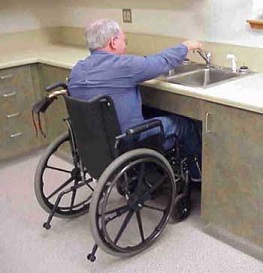
An accessible kitchen sink at the Quincy Barracks.
Forest: Plumas
District: Mt. Hough
Region: 5
If an employee with a disability is hired or transferred to a position that is stationed in an office that is not accessible, the office must be retrofitted immediately. In most cases, accessibility must be provided throughout the facility. The rest room, meeting room, break room, and other group-use areas must be made accessible. Temporary arrangements must sometimes be made while renovations are in progress. For instance, if one floor of the facility is accessible, the staff group with whom the employee will be working can be moved to the accessible floor so they can work easily and effectively as a team that includes the new employee.
According to law, "too expensive" is not an acceptable reason to postpone accessibility renovations. The Department of Justice has ruled that unless Federal agencies can show that any needed single renovation would have a significant negative impact on the entire agency’s budget, renovations that are needed by employees with disabilities to do their jobs must be completed immediately. Other existing facilities must be evaluated for accessibility and a transition plan must be developed and implemented for those that are not accessible.
For more information on how to describe a facility that is not accessible, see the What terms will let people know whether our facility is accessible? section of this toolbox.
Where must the wheelchair symbol be posted?
Signs provide key information concerning the accessibility of programs and facilities. The International Symbol of Accessibility (ISA), the familiar person-in-a-wheelchair logo, is the most common and easily recognized symbol designating accessibility. Unfortunately, the ISA and other international symbols relating to accessibility are sometimes misused.

ADA/ABA Accessibility Guidelines specify the circumstances under which the ISA and other symbols should be used.
The ISA must be posted in only four places, according to the UFAS and ADAAG:
-
Accessible parking spaces
-
Accessible rest rooms
-
Accessible loading zones
-
Accessible entrances to a building if the main entrance is not accessible
Accessible Parking Spaces and Loading Zones
The only legal requirement for accessible parking spaces is to post a sign with the ISA, in high contrast colors, at each space. The word "van" must be on the sign at the van-accessible parking space. The term "handicapped" should not be used on parking or loading zone signs. See the terminology page of this toolbox for a discussion of the term "handicapped."
There is no legal requirement for land management agencies to use blue-and-white colors on the signs at accessible parking spaces or loading zones located on Federal lands. Signs with the ISA can be brown with a cream or yellow symbol and lettering that blends into Forest Service signage.
However, if you intend to enforce accessible parking areas by ticketing those parked inappropriately, your signs must comply with the Manual on Uniform Traffic Control Devices (MUTCD) , Section 2B.35. Sign R7-8 includes the term "reserved parking" and the ISA in blue and white.
The only approved color for pavement markings designating accessible parking spaces is blue: MUTCD 3B.18.
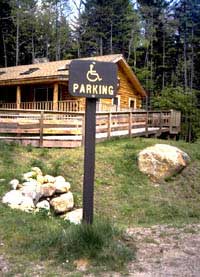
The cream and brown sign lets visitors know this parking space is accessible, but follows the same color scheme as other signs in the area.
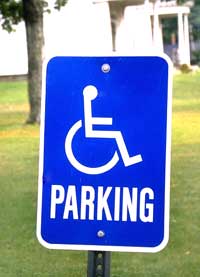
Vehicles without the appropriate license plate, tag, or sticker can receive a ticket for parking in this space.
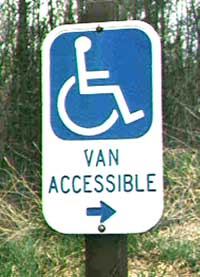
Vans are directed to the appropriately sized space. Vehicles without the appropriate license plate, tag, or sticker could be ticketed for parking there.
Rest rooms
The ISA and gender designation must be posted at all accessible rest rooms on the wall beside the latch side of the door, 60 inches above the floor. See the ADA/ABA Accessibility Guidelines section 703 Signs for specifics on colors, symbols, and characters, including raised and Brailled letters and numbers.
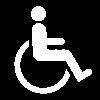
Entrance Signs
The ISA can be posted on the main entrance sign to a facility to indicate that ALL of the facility meets the UFAS or ADAAG. Don't use the ISA on the entry sign for any facility that does not meet the Federal accessibility standards completely, or you will have some unhappy customers. Be careful where the ISA is used!
Adaptive Equipment and Services
It's usually helpful to post the appropriate international symbols where services such as sign language interpreters or adaptive equipment such as teletypewriters or assistive listening systems are available. Some of the relevant international symbols are shown below.
Trails
Where pedestrian trails have been evaluated for accessibility, post the following information in addition to the standard message with the trail name, number, destination, and distance:
-
Typical and maximum trail grade
-
Minimum trail width
-
Typical and maximum cross slope
-
Trail surface (type and firmness of surface)
-
Any major obstacle, such as boulders in the trail tread
More information about pedestrian trails is available in the Forest Service Trails Accessibility Guidelines and the Accessibility Guidebook for Outdoor Recreation and Trails.
Updates to accessibility guidelines and terminology
Do NOT use the term "handicapped" on parking signs or any other signage. See the sections on terminology and accessibility status for an explanation of why this term is unacceptable.
Do NOT follow the sign information in the 1993 publication Universal Access to Outdoor Recreation, A Design Guide with its three levels of difficult, easier, moderate.
Do NOT follow the sign information in the 1999 Draft Outdoor Recreation Developed Areas accessibility recommendations. In particular, don't post the ISA at all accessible campsites.
DO follow the sign guidance in the draft Forest Service accessibility guidelines for outdoor recreation and trails. You can follow the development process and use the latest draft versions posted at the accessibility program area of the Forest Service’s Web site.
Where can I learn more about accessibility?
The Forest Service Accessibility Program Website contains Forest Service accessibility guidelines and guidebooks for outdoor recreation and trails, ski areas, incident facilities, exhibits, and wilderness as well as other information about accessibility and links to accessibility laws, regulations, and policies.
The Accessibility Program internal Forest Service website (available only from Forest Service and BLM computers) includes links to other accessibility web sites and to on-line training.
The PATHFINDERS internal Forest Service website (available only from Forest Service and BLM computers) provides information to all employees about disability issues.
The USDA TARGET Center Website was established to ensure that all USDA employees have safe and equal access at work by assessing, educating, and advocating for the integration of assistive technology and worksite accommodations.
The United States Access Board Website contains information on national accessibility guidelines, standards, research, publications, and training.
The GSA Accessibility Website provides information about accessibility requirements for buildings owned and managed by the General Services Administration, the "landlord" for the Federal Government.
The GSA Section 508 Website contains information about requirements for electronic and information technology accessibility.
Disability Resources is a Webpage of the U.S. Department of Labor's Office of Disability Employment Policy with lists of links to information on benefits, civil rights, community life, employment, and education.
The Website of the National Center on Accessibility provides research, technical assistance and education focused on universal design and practical accessibility solutions to create inclusive recreation opportunities for people of all abilities.
The Partnership on Employment & Accessible Technology is an initiative to foster collaboration and action around accessible technology in the workplace.

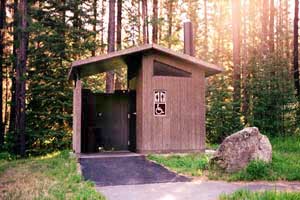







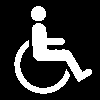
User Comments/Questions
Add Comment/Question